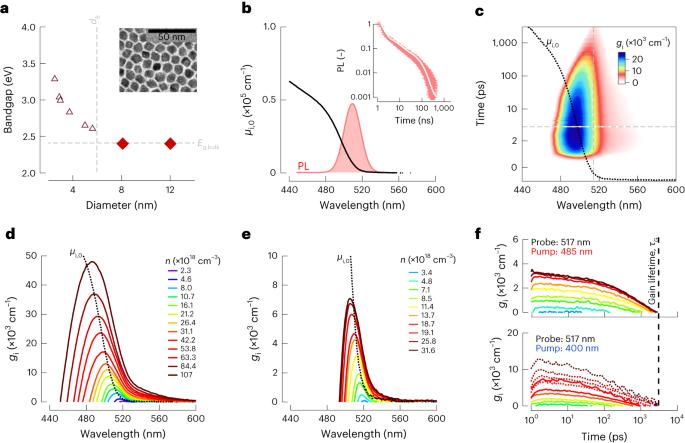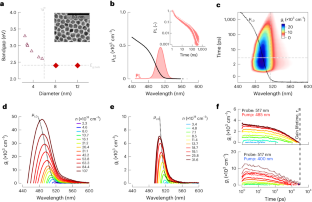Optical gain and lasing from bulk cadmium sulfide nanocrystals through bandgap renormalization
IF 38.1
1区 材料科学
Q1 MATERIALS SCIENCE, MULTIDISCIPLINARY
引用次数: 0
Abstract
Strongly confined colloidal quantum dots have been investigated for low-cost light emission and lasing for nearly two decades. However, known materials struggle to combine technologically relevant metrics of low-threshold and long inverted-state lifetime with a material gain coefficient fit to match cavity losses, particularly under electrical excitation. Here we show that bulk nanocrystals of CdS combine an exceptionally large material gain of 50,000 cm−1 with best-in-class gain thresholds below a single exciton per nanocrystal and 3 ns gain lifetimes not limited by non-radiative Auger processes. We quantitatively account for these findings by invoking a strong bandgap renormalization effect, unobserved in nanocrystals to date, to the best of our knowledge. Next, we demonstrate broadband amplified spontaneous emission and lasing under quasi-continuous-wave conditions. Our results highlight the prospects of bulk nanocrystals for lasing from solution-processable materials. Solution-processable CdS ‘bulk’ nanocrystals show efficient on-chip lasing under quasi-continuous-wave conditions with excellent beam quality and pump thresholds.


大块硫化镉纳米晶体通过带隙重整化的光学增益和激光。
近二十年来,强约束胶体量子点一直被研究用于低成本的发光和激光发射。然而,已知的材料很难将低阈值和长反向态寿命的技术相关指标与适合匹配腔损耗的材料增益系数相结合,特别是在电激励下。在这里,我们展示了CdS的大块纳米晶体结合了50000的异常大的材料增益 cm-1,每个纳米晶体具有低于单个激子的同类最佳增益阈值和3 ns增益寿命不受非辐射俄歇过程的限制。据我们所知,我们通过援引迄今为止在纳米晶体中未观察到的强带隙重整化效应来定量解释这些发现。接下来,我们演示了准连续波条件下的宽带放大自发发射和激光发射。我们的研究结果突出了从溶液可加工材料中发射激光的大块纳米晶体的前景。
本文章由计算机程序翻译,如有差异,请以英文原文为准。
求助全文
约1分钟内获得全文
求助全文
来源期刊

Nature nanotechnology
工程技术-材料科学:综合
CiteScore
59.70
自引率
0.80%
发文量
196
审稿时长
4-8 weeks
期刊介绍:
Nature Nanotechnology is a prestigious journal that publishes high-quality papers in various areas of nanoscience and nanotechnology. The journal focuses on the design, characterization, and production of structures, devices, and systems that manipulate and control materials at atomic, molecular, and macromolecular scales. It encompasses both bottom-up and top-down approaches, as well as their combinations.
Furthermore, Nature Nanotechnology fosters the exchange of ideas among researchers from diverse disciplines such as chemistry, physics, material science, biomedical research, engineering, and more. It promotes collaboration at the forefront of this multidisciplinary field. The journal covers a wide range of topics, from fundamental research in physics, chemistry, and biology, including computational work and simulations, to the development of innovative devices and technologies for various industrial sectors such as information technology, medicine, manufacturing, high-performance materials, energy, and environmental technologies. It includes coverage of organic, inorganic, and hybrid materials.
 求助内容:
求助内容: 应助结果提醒方式:
应助结果提醒方式:


